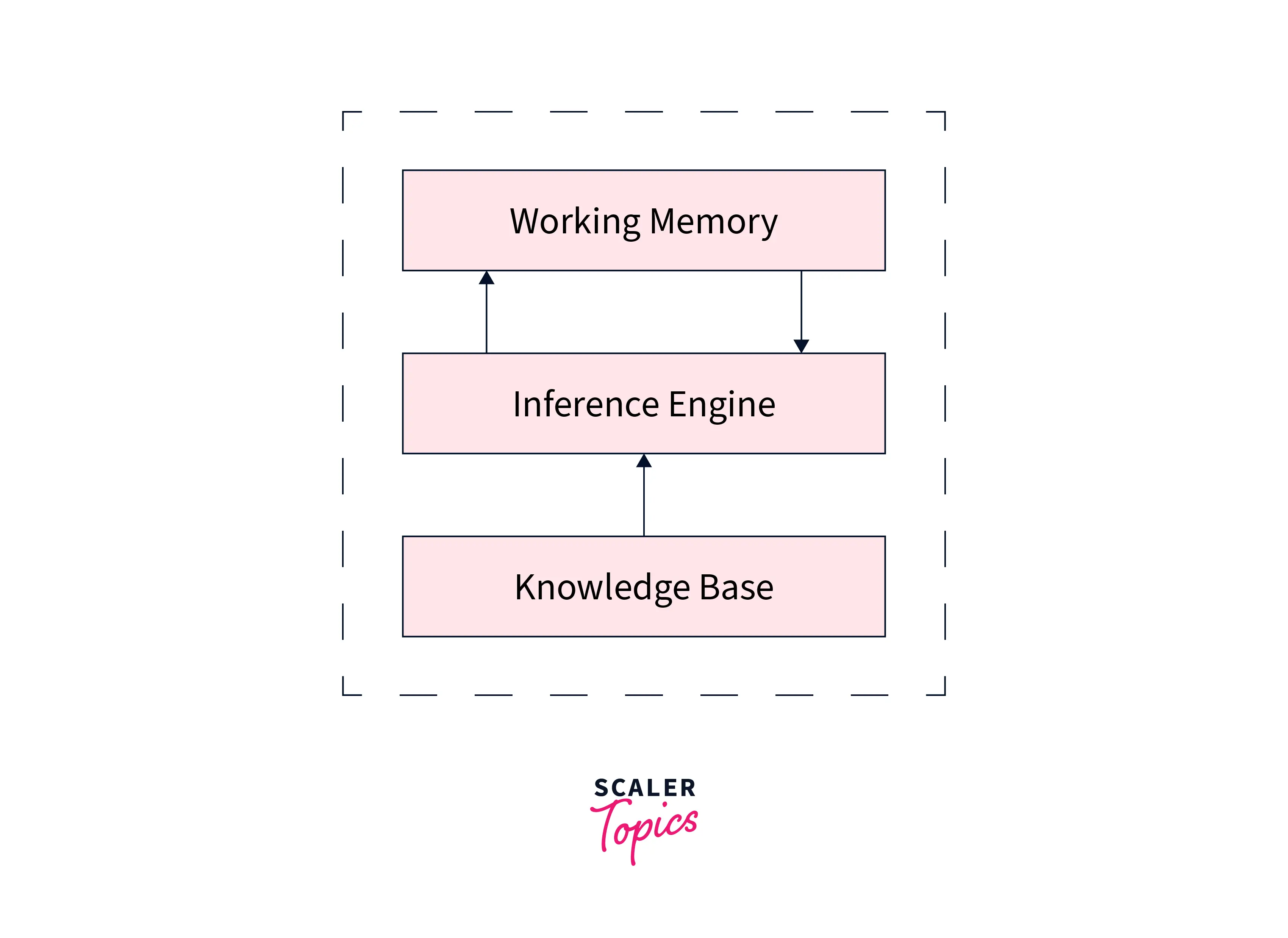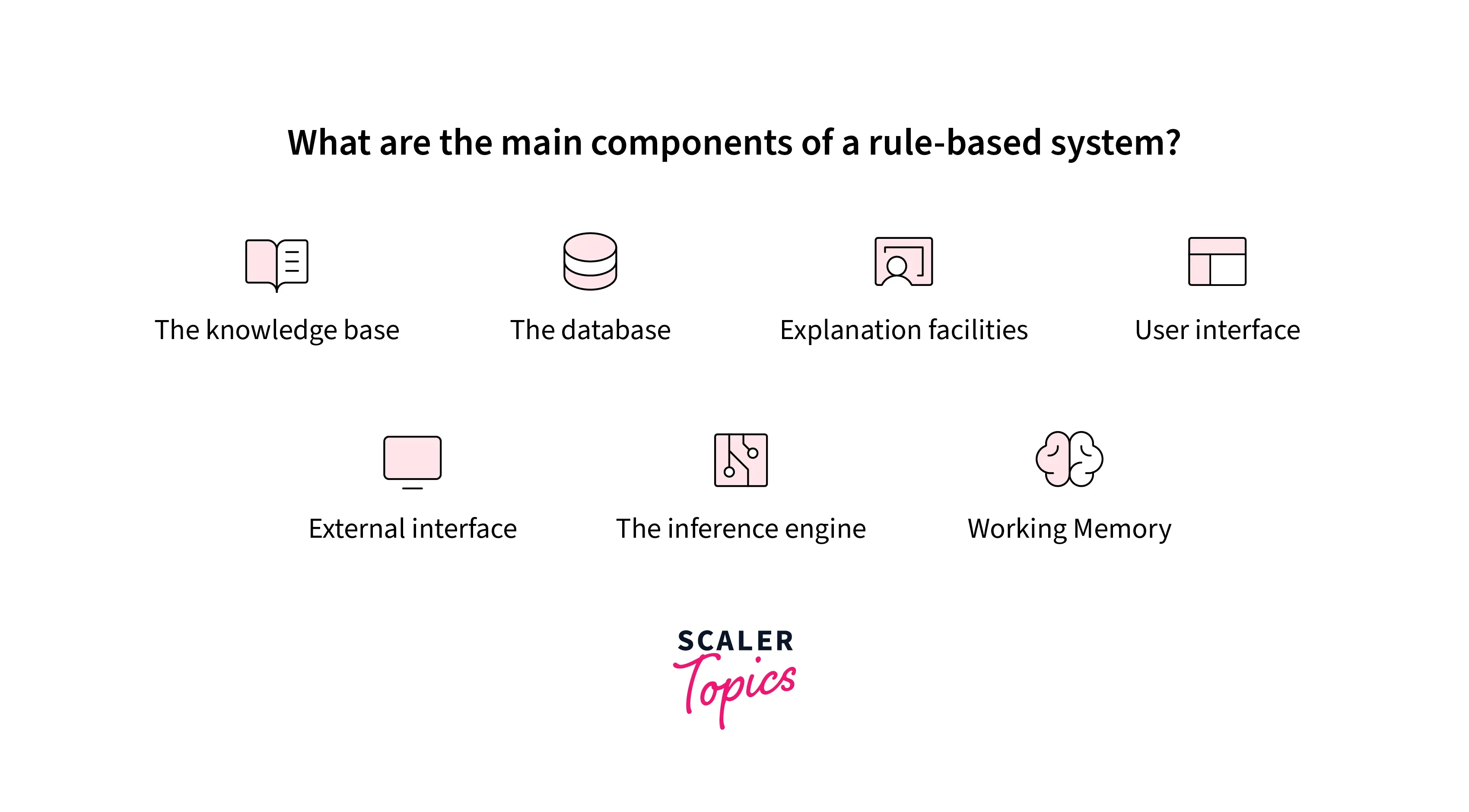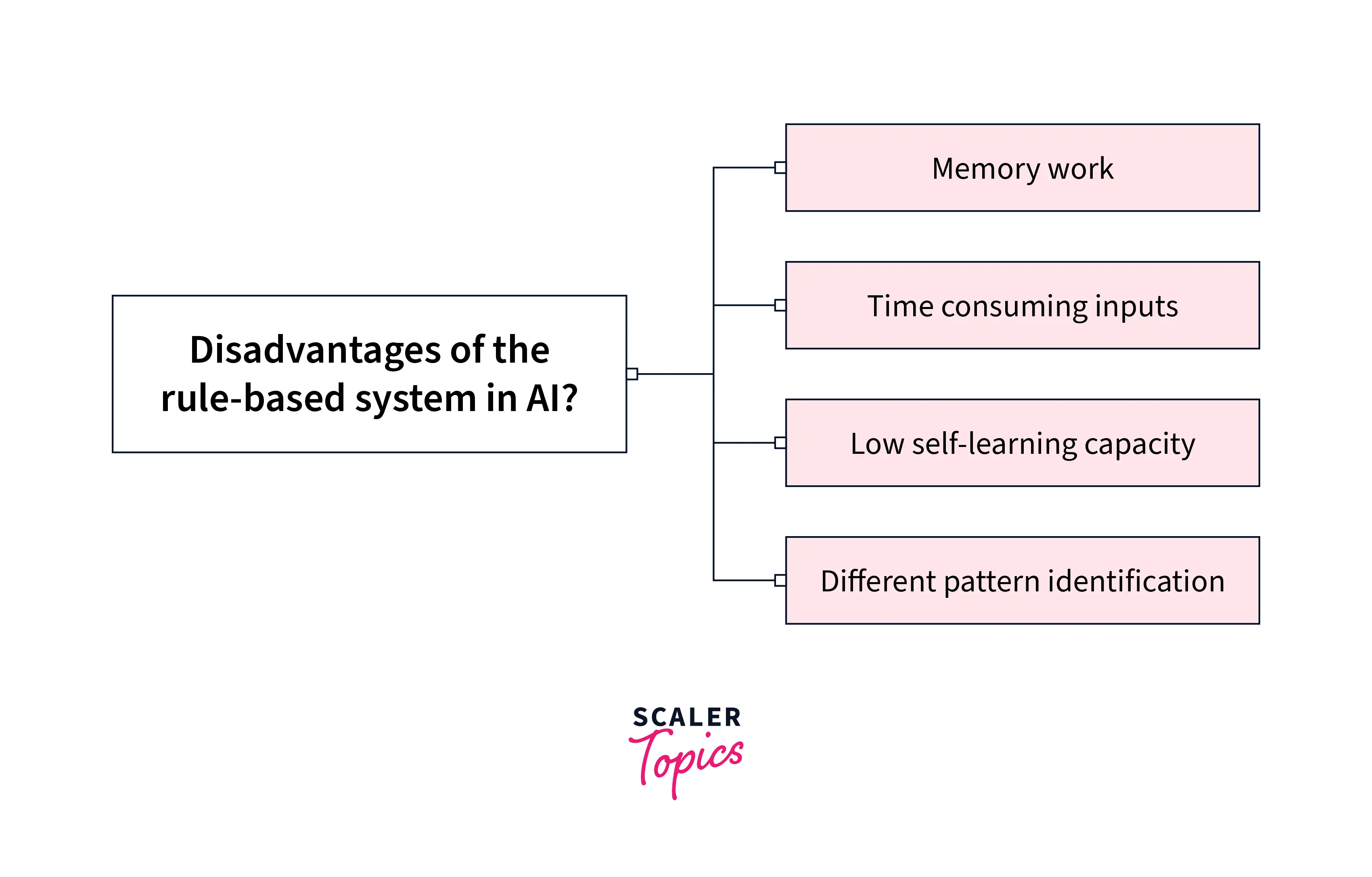Rule-based Systems in AI
Overview
In the world of technology, Artificial intelligence is gaining importance. Rule-based systems are one of the earliest and most well-established types of AI. Let's understand the rule-based system in AI. We'll discuss what a rule-based system in AI is, its traits, operation, key elements, examples, and how to build it.
Introduction
The rule-based system in AI bases choices or inferences on established rules. These laws are frequently expressed in human-friendly language, such as "if X is true, then Y is true," to make them easier for readers to comprehend. Expert and decision support systems are only two examples of the many applications in which rule-based systems have been employed.
What is a Rule-based System?

A system that relies on a collection of predetermined rules to decide what to do next is known as a rule-based system in AI. These laws are predicated on several circumstances and deeds. For instance, if a patient has a fever, the doctor may recommend antibiotics because the patient may have an infection. Expert systems, decision support systems, and chatbots are examples of apps that use rule-based systems.
Characteristics of Rule-based Systems in AI
The following are some of the primary traits of the rule-based system in AI:
- The rules are written simply for humans to comprehend, making rule-based systems simple to troubleshoot and maintain.
- Given a set of inputs, rule-based systems will always create the same output, making them predictable and dependable. This property is known as determinism.
- A rule-based system in AI is transparent because the standards are clear and open to human inspection, which makes it simpler to comprehend how the system operates.
- A rule-based system in AI is scalable. When scaled up, large quantities of data can be handled by rule-based systems.
- Rule-based systems can be modified or updated more easily because the rules can be divided into smaller components.
How does a Rule-based System Work?
A rule-based system in AI generates an output by using a collection of inputs and a set of rules. The system first determines which principles apply to the inputs. If a rule is applicable, the system executes the corresponding steps to generate the output. If no guideline is applicable, the system might generate a default output or ask the user for more details.
Main Components of a Rule-based System

Typically, a rule-based system in AI consists of seven fundamental elements:
-
The knowledge base:
It contains the specialized expertise required for problem-solving. The information is represented as a set of rules in a rules-based system. Every rule has an IF (condition) THEN (action) structure and defines a relationship, suggestion, directive, strategy, or heuristic. The rule is activated, and the action portion is carried out as soon as the conditional portion of the rule is met. -
The database:
The database contains a collection of facts compared to the knowledge base's rules IF (condition) clause. -
The inference engine:
The expert system uses the inference engine to derive the logic and arrive at a conclusion. The inference engine's task is to connect the facts kept in the database with the rules specified in the knowledge base. The semantic reasoner is another name for the reasoning engine. It deduces information or executes necessary actions based on data and the rule base present in the knowledge base. For example, the match-resolve-act loop used by the semantic reasoner goes like this:- Match:
A portion of the production rule system is compared to the information in the working memory to create a conflict in which numerous examples of satisfied productions are present. - Conflict Resolution:
Following the matching of the production systems, one of the production cases involved in the conflict will be executed to gauge the procedure's status. - Act:
The production instance chosen in the step before is carried out, changing the information in the working memory.
- Match:
-
Explanations facilities:
The user can use the explanation facilities to question the expert system on how it came to a particular conclusion or why a particular fact is necessary. The expert system must be able to defend its logic, recommendations, analyses, and conclusions. -
User Interface:
The user interface is the channel through which the user interacts with the expert system to find a solution to an issue. The user interface should be as simple and intuitive as possible, and the dialogue should be as helpful and friendly as possible.Each of these five components is essential to any rule-based system in AI. These form the basis of the rule-based structure. However, the mechanism might also include a few extra parts. The working brain and the external interface are two examples of these parts.
-
External connection:
An expert system can interact with external data files and programs written in traditional computer languages like C, Pascal, FORTRAN, and Basic, thanks to the external interface. -
Active recall:
The working memory keeps track of transient data and knowledge.
Examples of Rule-based Systems
Healthcare, finance, and engineering are just a few examples of the sectors and applications that use rule-based systems. Following are some instances of a rule-based system in AI:
- Medical Diagnosis:
Based on a patient's symptoms, medical history, and test findings, a rule-based system in AI can make a diagnosis. The system can make a diagnosis by adhering to a series of guidelines developed by medical professionals. - Fraud Detection:
Based on particular criteria, such as the transaction's value, location, and time of day, a rule-based system in AI can be used to spot fraudulent transactions. The system, for the additional examination, can then flag the transaction. - Quality Control:
A rule-based system in AI can ensure that products satisfy particular quality standards. Based on a set of guidelines developed by quality experts, the system can check for flaws. - Decision support systems:
They are created to aid decision-making, such as choosing which assets to buy or what to buy.
How to Create a Rule-based System?
The following actions are required to develop a rule-based system:
- Determine the issue:
Decide what issue needs to be resolved by a rule-based system. - Establish the rules:
Establish a collection of guidelines that can be used to address the issue. The laws ought to be founded on professional expertise or data analysis. - Implement the rules:
In a rule-based structure, implement the rules. Software tools that enable the development and administration of rule-based systems can be used for this. - Test and evaluate:
Verify that the rule-based system in AI operates as intended. Take stock of how it's performing and make any required modifications.
Rule-based System vs. Learning-based System
| Rule-Based Systems | Learning-Based Systems |
|---|---|
| Uses a set of predetermined rules to make decisions | Learns from data to make decisions |
| Rules are created by human experts | Knowledge is acquired through machine learning algorithms |
| Limited ability to adapt to new situations | Can adapt to new situations by learning from data |
| Transparent decision-making process | Decision-making process may not be transparent |
| Scalable by adding or modifying rules | Scalable by retraining the model |
| Consistent in decision-making | Decision-making may not always be consistent |
| Fast decision-making | May require significant time for training the model |
Rule-based System vs. Machine Learning System
| Rule-Based Systems | Machine Learning |
|---|---|
| Uses a set of predetermined rules to make decisions | Uses statistical models to make decisions |
| Rules are created by human experts | Models are trained using data |
| Limited ability to adapt to new situations | Can adapt to new situations by retraining the model |
| Transparent decision-making process | Decision-making process may not be transparent |
| Scalable by adding or modifying rules | Scalable by adding more data or retraining the model |
| Consistent in decision-making | Decision-making may not always be consistent |
| Fast decision-making | May require significant time for training the model |
| Examples: Medical diagnosis, fraud detection | Examples: Image recognition, speech recognition |
Advantages of Rule-based Systems in AI
- Transparency and Explainability:
Because the rules are openly established, rule-based systems are transparent and simple to comprehend. This makes it simpler for programmers to comprehend and adjust the system and for users to comprehend the rationale behind particular actions. - Efficiency:
Rule-based systems work quickly and effectively since they don't need a lot of data or intricate algorithms to function. Instead, they merely conclude by applying rules to a specific scenario. - Accuracy:
Because they rely on a set of clear rules and logical inferences, rule-based systems have the potential to be very accurate. The system will produce the right outcomes if the rules are written correctly. - Flexibility:
Rule-based systems are updated and modified by adding or modifying the rules. Because of this, they can easily adjust to new situations or knowledge.
Disadvantages of Rule-based Systems in AI

- Restricted Capabilities for Learning:
Rule-based systems are created to function according to predetermined rules and logical inferences. They are incapable of growing from mistakes or adjusting to novel circumstances. As a result, they may need to improve at addressing complicated or dynamic situations. - Difficulty Handling Uncertainty:
Rule-based systems may need more clarity or complete information. Any ambiguity in the data can result in errors or bad outcomes because they need precise inputs and rules to make a decision. - High Maintenance Costs:
To keep the rules accurate and up to date, rule-based systems need continual maintenance. The cost and effort needed to maintain the system rise along with its complexity. - Difficulty Handling Complex Interactions:
Complicated interactions can be difficult for rule-based systems, especially when several separate rules or inputs are involved. Sometimes, the consequences of this can be conflicting or inconsistent.
Conclusion
- A rule-based system in AI uses a set of rules to generate judgments or suggestions.
- Because they can swiftly evaluate data and deliver precise answers, these systems are common in the banking, healthcare, and customer service sectors.
- Rule-based systems benefit from being transparent because the rules are clearly stated, simplifying comprehension of how the system came to a particular decision.
- The rule-based system in AI should be as effective as possible. Thus it's critical to carefully design, test, and iteratively improve the rules based on user feedback and new data.
